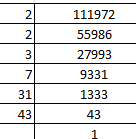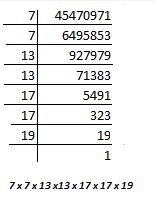

12576=4052*3 + 420
4052=420*9 + 272
420=272 * 1 + 148
272=148*1 + 124
148=124*1 + 24
124=24*5+ 4
24=4*6 + 0
Hence HCF is 4
LCM of 35, 56 and 91= 3640
Hence the number is =3640+7=3647
Let a be any odd positive integer and b=4.
By division lemma there exist integer q and r such that
a = 4 q + r, where 0 ≤ r < 4
or a = 4q or, a = 4q +1 or, a = 4q + 2 or, a = 4q +3
Now 4q and 4q+2 are even numbers
so a= 4q +1 or, a = 4q +3
Hence , any odd integer is of the form 4q + 1 or, 4q +3.
HCF x LCM= Product of the Numbers
Hence the other number is = (2295 * 9)/153=135

111972=2 * 2 * 3 * 7 * 31 * 43
448=$2^6 \times 7$
1008=$2^4 \times 3^2 \times 7$
168=$2^3 \times 3 \times 7$
Hence
HCF=56
LCM=4032
HCF=29
LCM=30065
HCF=4
LCM=22320
For this we have to find L.C.M of 36 and 54.
L.C.M. of 36 and 54 = 2*2*3*3*3 = 108
Now,
The least number = (L.C.M. of 36 and 54) + 5
=108+5 = 113
Hence 113 is the least positive integer which on diminished by 5 is exactly divisible by 36 and 54.
HCF=3
LCM=2772
144=$2^4 \times 3^2$
Here we need to find the LCM for the numbers 4,12,20
By prime factorisation
4= 22
12=22*3
20= 22*5
LCM = 22*3*5=60 min
Here we need to find the LCM for the numbers 48,60,72
By prime factorisation
48= 24*3
60=22*3*5
72= 23*32
LCM = 24*32*5=720 km
So 2 rounds

The capacity of required container will be obtained by finding the HCF of the capacity of tankers
By prime factorisation
850 = 2�52*17
680 = 23*5*17
HCF = 2*5*17
= 170 Litres
Given that traffic light at three different road crossing change after every 36 seconds,60 seconds and 72 seconds respectively.
36 = 2 * 2 * 3 * 3
60 = 2 * 2 * 3 * 5
72 = 2 * 2 * 2 * 3 * 3
Hence LCM of 36, 60 and 72 = (2 * 2 * 2 * 3 * 3 * 5)
= 360
That is after 360 seconds(5 Min) they will change simultaneously
Thus the traffic lights change simultaneously at 8:05 am
HCF=1

length of rectangular courtyard = 18 m 72 cm =18X100 +72= 1872 cm
Width of rectangular courtyard = 13 m 20 cm=13X100+20= 1320 cm
To find the square tile of maximum side we take the HCF of 1872 and 1320
By Euclid�s division lemma we have
1872 = 1320 * 1 + 552
1320 = 552 * 2 + 216
552 = 216 * 2 + 120
216 = 120 * 1 + 96
120 = 96 * 1 + 24
96 = 24 * 4 + 0
Hence the HCF is 24
Therefore maximum side of the square = 24 cm
Number of tiles required = (Area of rectangular courtyard)/(Area of square tile)
= (1872 * 1320)/(24 * 24)
= 4290
The least number divisible by all the numbers from 1 to 10 will be the LCM of these numbers.
By prime factorisation
1 = 1
2 = 2 * 1
3 = 3 * 1
4 = 22
5 = 5 * 1
6 = 2 * 3
7 = 7 * 1
8 = 23
9 = 32
10 = 2 * 5
LCM= 1 * 2 * 2 * 2 * 3 * 3 * 5 * 7 = 2520
This Class 10 Maths Real Numbers Worksheets with answers is prepared keeping in mind the latest syllabus of CBSE . This has been designed in a way to improve the academic performance of the students. If you find mistakes , please do provide the feedback on the mail.
Go back to Class 10 Main Page using below links